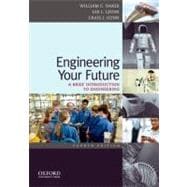
| Preface | p. vii |
| The History of Engineering | p. 1 |
| Introduction | p. 1 |
| Getting Started | p. 2 |
| The Beginnings of Engineering | p. 5 |
| An Overview of Ancient Engineering | p. 7 |
| Traveling Through the Ages | p. 9 |
| Exercises and Activities | p. 14 |
| Engineering Majors | p. 17 |
| Introduction | p. 17 |
| Engineering Functions | p. 21 |
| Engineering Majors | p. 29 |
| Emerging Fields | p. 50 |
| Closing Thoughts | p. 51 |
| References | p. 52 |
| Exercises and Activities | p. 52 |
| Profiles of Engineers | p. 57 |
| A Statistical Profile of the Engineering Profession | p. 87 |
| Statistical Overview | p. 87 |
| College Enrollment Trends of Engineering Students | p. 87 |
| College Majors of Recent Engineering Students | p. 89 |
| Degrees in Engineering | p. 89 |
| Job Placement Trends | p. 89 |
| Salaries of Engineers | p. 91 |
| The Diversity of the Profession | p. 99 |
| Distribution of Engineers by Field of Study | p. 103 |
| Engineering Employment by Type of Employer | p. 104 |
| Percent of Students Unemployed or in Graduate School | p. 104 |
| A Word from Employers | p. 105 |
| Exercises and Activities | p. 105 |
| Succeeding in the Classroom | p. 107 |
| Introduction | p. 107 |
| Attitude | p. 107 |
| Goals | p. 108 |
| Keys to Effectiveness | p. 109 |
| Test-taking | p. 114 |
| Making the Most of Your Professors | p. 116 |
| Learning Styles | p. 117 |
| Well-Rounded Equals Effective | p. 119 |
| Your Effective Use of Time | p. 122 |
| Accountability | p. 127 |
| Overcoming Challenges | p. 127 |
| References | p. 128 |
| Exercises and Activities | p. 129 |
| Problem Solving | p. 133 |
| Introduction | p. 133 |
| Analytic and Creative Problem Solving | p. 134 |
| Analytic Problem Solving | p. 136 |
| Creative Problem Solving | p. 142 |
| Personal Problem Solving Styles | p. 150 |
| Brainstorming Strategies | p. 153 |
| Critical Thinking | p. 158 |
| References | p. 160 |
| Exercises and Activities | p. 160 |
| Computer Tools for Engineers | p. 167 |
| The Internet | p. 167 |
| Word Processing Programs | p. 173 |
| Spreadsheets | p. 174 |
| Mathematics Software | p. 177 |
| Presentation Software | p. 180 |
| Operating Systems | p. 181 |
| Exercises and Activities | p. 181 |
| Teamwork | p. 183 |
| Introduction | p. 183 |
| Engineers Often Work in Teams | p. 183 |
| Team Growth Stages | p. 188 |
| What Makes a Successful Team? | p. 190 |
| Team Leadership | p. 191 |
| Team Organizational Structures | p. 193 |
| Effective Decision Making | p. 194 |
| Attitudes Toward Team Experiences | p. 195 |
| Documenting Team Performance | p. 196 |
| References | p. 198 |
| Exercises and Activities | p. 198 |
| Engineering Design | p. 201 |
| What Is Engineering Design? | p. 201 |
| The Design Process | p. 202 |
| Exercises and Activities | p. 211 |
| Communication Skills | p. 215 |
| Why Do We Communicate? | p. 215 |
| Oral Communication Skills | p. 216 |
| Written Communication-Skills | p. 222 |
| Other Types of Communication | p. 228 |
| Exercises and Activities | p. 236 |
| Ethics and Engineering | p. 239 |
| Introduction | p. 239 |
| The Nature of Ethics | p. 239 |
| The Nature of Engineering Ethics | p. 240 |
| The Issues and Topics of Engineering Ethics | p. 243 |
| Exercises and Activities | p. 255 |
| Engineering Work Experience | p. 259 |
| A Job and Experience | p. 259 |
| Summer Jobs and On- and Off-Campus Work Experiences | p. 261 |
| Volunteer or Community Service Experiences | p. 261 |
| Supervised Independent Study or Research Assistantship | p. 262 |
| Internships | p. 262 |
| Cooperative Education | p. 263 |
| Which Is Best for You? | p. 268 |
| Exercises and Activities | p. 268 |
| Appendix: The Basics of PowerPoint | p. 271 |
| Index | p. 275 |
| Table of Contents provided by Ingram. All Rights Reserved. |
The New copy of this book will include any supplemental materials advertised. Please check the title of the book to determine if it should include any access cards, study guides, lab manuals, CDs, etc.
The Used, Rental and eBook copies of this book are not guaranteed to include any supplemental materials. Typically, only the book itself is included. This is true even if the title states it includes any access cards, study guides, lab manuals, CDs, etc.